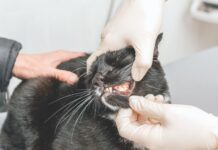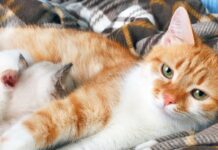When our one-year-old female cat enters rapid eye movement (REM) sleep, she begins twitching and suddenly throws herself several feet backward. Sometimes she growls while asleep and then thrashes wildly; she acts as if she is dreaming but she reacts violently. She chews, claws and acts as if shes being attacked, and she also passes urine during most of these sleep episodes. Shes difficult to arouse, but once awake, she appears normal. Her laboratory test results were normal. She has been medicated with valium and phenobarbital, but neither medication had any effect. Is there anything we can do?
There is only a handful of feline sleep disorder cases reported in the veterinary literature, but a few sound remarkably similar to what youve described. The rarity of feline reports is in sharp contrast to the situation in humans, where great advances have been made in the recognition, diagnosis and treatment of sleep disorders.
The Internet contains a wealth of information on human sleep disorders, some of which also relates to cats. A good place to search for information is the Sleep Medicine Home Page at www.users.cloud9.net/~thorpy/.
Complex Event
Sleep is an extremely complex neurophysiological event. In general, cats experience two phases of sleep: slow-wave sleep and fast-wave sleep, also called rapid eye movement (REM) sleep. In REM sleep, the muscles that control eye movement are randomly active, so the eyes rapidly flick about under the eyelids. Cats in REM sleep may twitch their facial muscles, tails, ears and whiskers. Dogs tend to be a bit more active in REM sleep than are kitties, with rhythmic paddling motions of all four legs and even whining. REM sleep is associated with dreaming in humans, and probably in cats and dogs, too. Its unlikely well ever know for sure.
Most of the cells in the brain are as active during REM sleep as they are during wakefulness, but a complex interaction of nerve cells and neural pathways in the brain and spinal cord inhibits – in essence, paralyzes – the major muscles that control body movement during this phase.
Presumably, this mechanism exists to keep sleepers from acting out their dreams. But if for some reason the muscles are not inhibited, then violent activity can ensue. In a report on cats experiencing excessive muscular activity during REM sleep, investigators at the School of Veterinary Medicine at the University of Pennsylvania noted that … the limb movements in all cases were so vigorous that the animals propelled themselves across the surface on which they were lying and moved objects in their paths. Sound familiar?
The good news is that your cat will almost certainly continue to live a normal life. I say almost certainly because theoretically its possible that there is some progressive abnormality – an enlarging mass in the central nervous system, for instance – disrupting the normal inhibitory pathways in the nervous system. If such is the case, then even her wakeful activity will ultimately become abnormal. Fortunately, in the majority of the reported cases of this behavior, there were no underlying abnormalities detected.
No Cure
There is no cure for this REM sleep disorder, but you can take some steps to make life with your cat a little easier. First, consider medication. Although the drugs youve tried so far havent been helpful, there is some indication that clonazepam may suppress some of the excessive movement during REM sleep disorders in cats. (Make sure to discuss this with your veterinarian.)
Trim the cats claws or cover them with nail caps to reduce the damage to the sleeping area when her legs lash out. And since she urinates during these episodes, protect her favorite sleeping spots with absorbent material.
Finally, remove from her sleeping area any objects that might injure her should she strike them.



